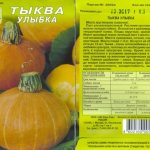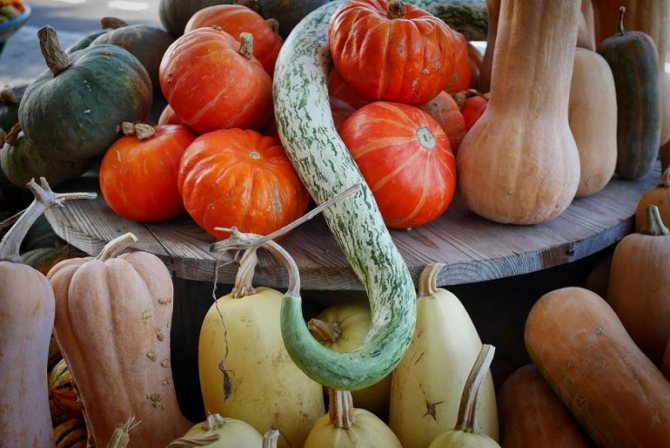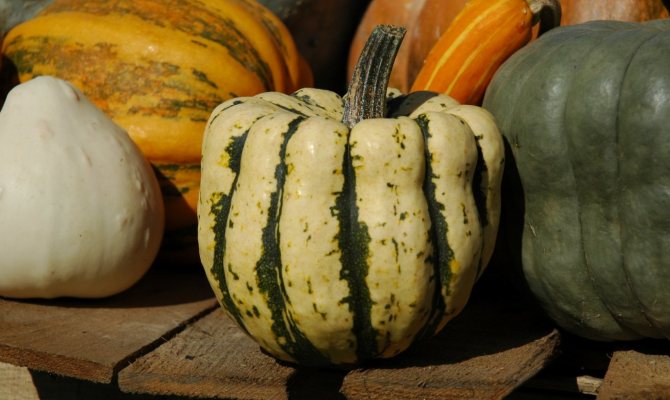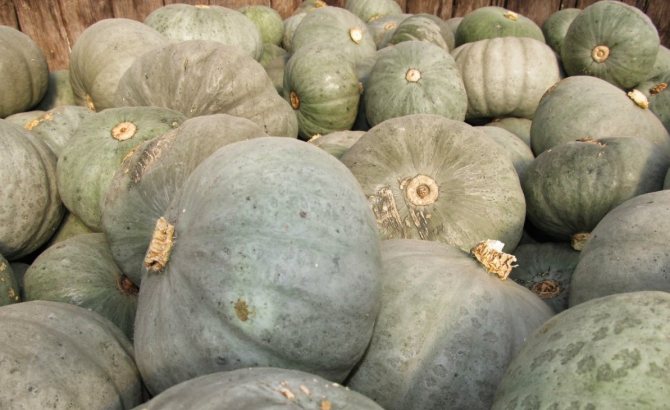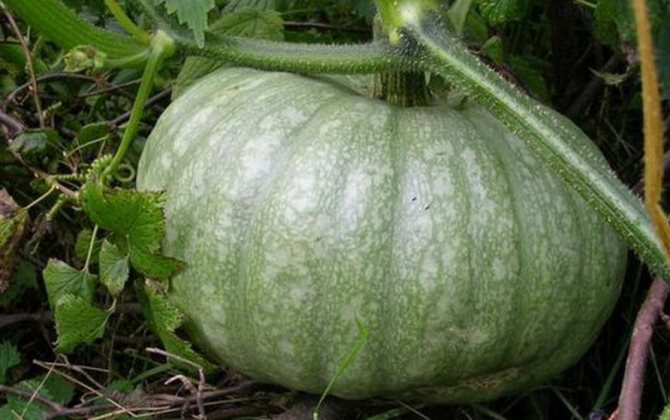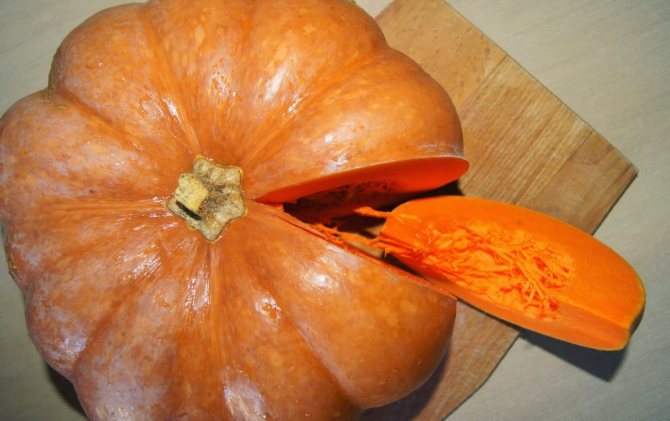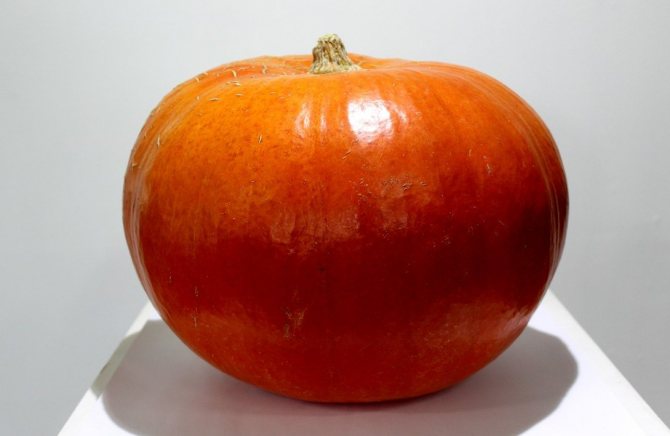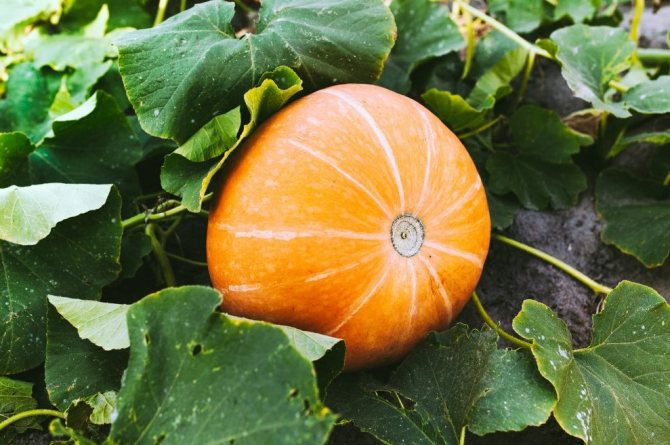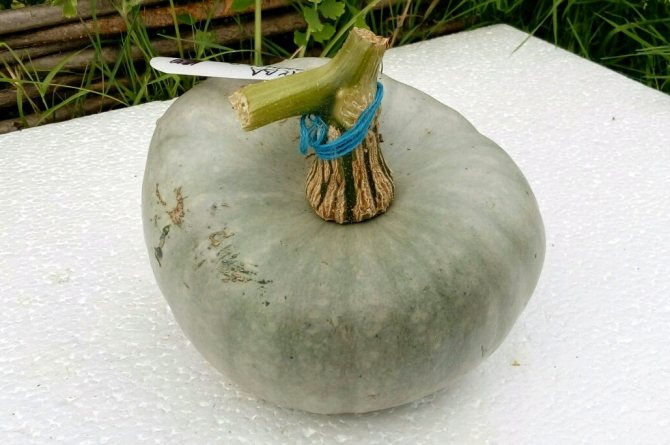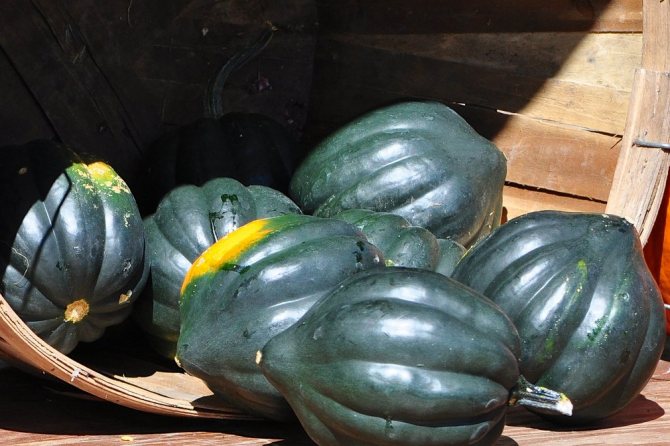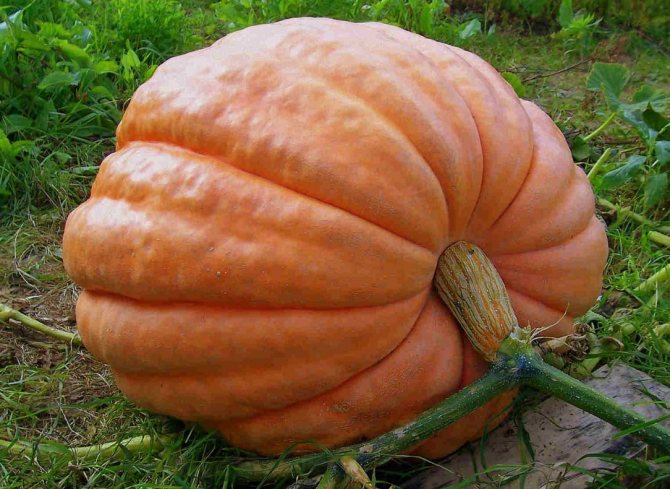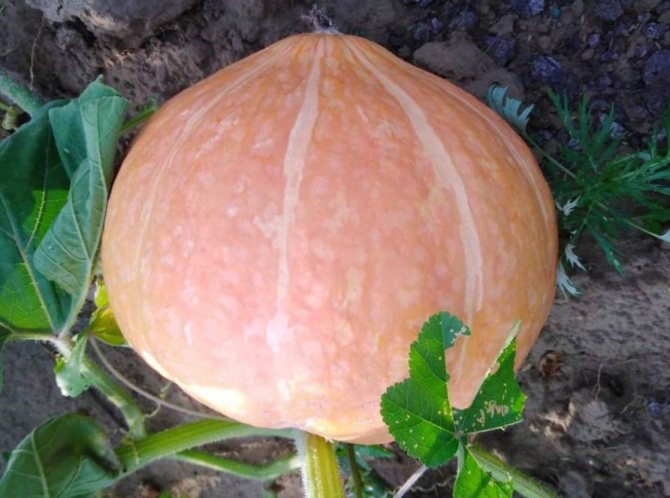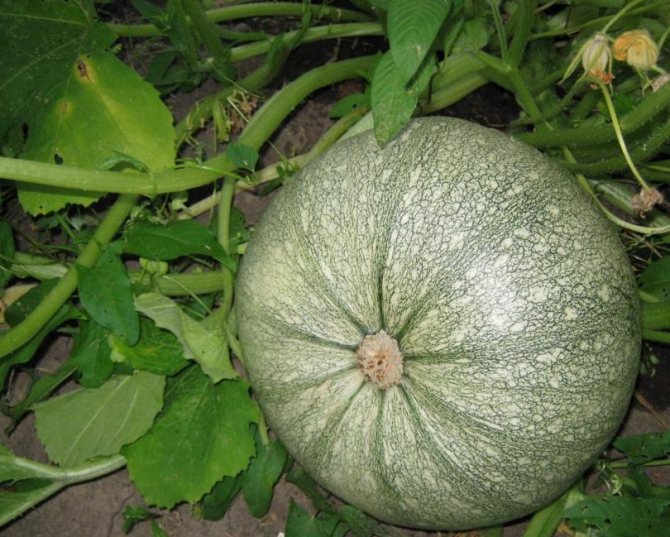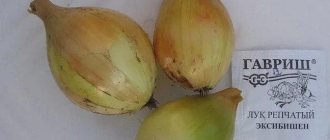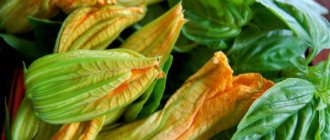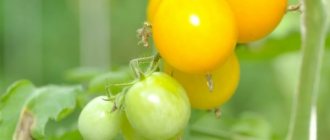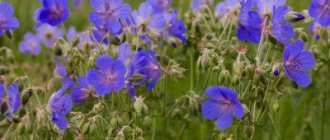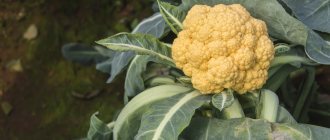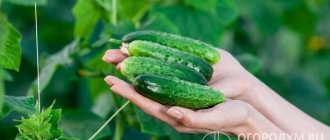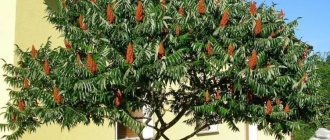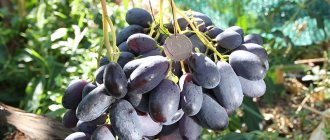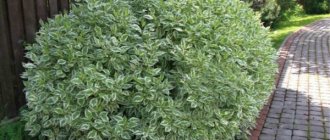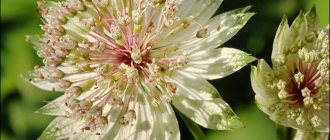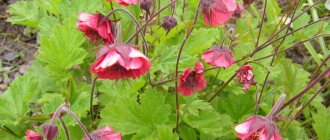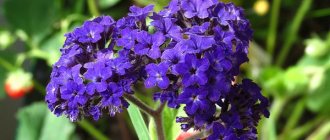Early varieties of pumpkin for open ground, description with photo
Early varieties are Amazonka, Smile, Acorn, Lel, Honey Beauty and Healing. All of them belong to bush.
Smile
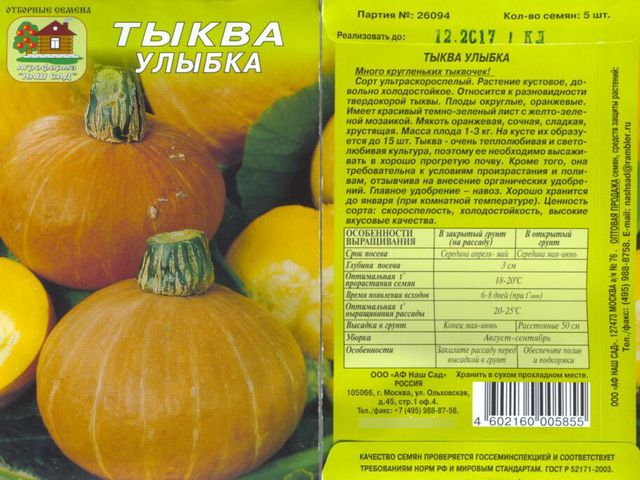
The variety is early maturing, cold-resistant, high-yielding. 15-20 fruits can be harvested from one plant.
Ripening time is short. So, from the moment the first shoots appear and until the harvest, only about three months pass (maybe a little more).
The fruits of this variety with such a positive name are small, from 1.5 to 2 kg. Orange color, sweet flesh. Despite the early terms of ripening and harvesting, pumpkin is stored for a long time - it can practically last until January.
It is often used for decorative purposes.
Freckle
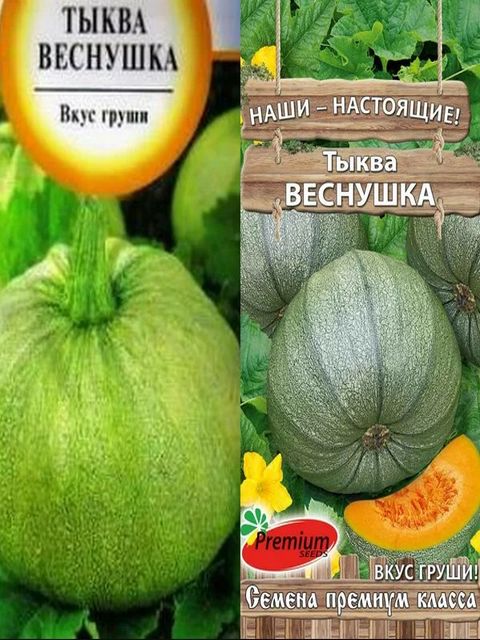

Another early variety with a spring name. It has a bushy shape and forms 4 to 6 lashes with short internodes. Fruits weigh up to 3 kg, light green with light spots. They can persist for quite a long time. The pulp has a delicate pear flavor and aroma.
The pumpkin feels good even if the weather conditions change. If you water regularly and abundantly, you can get a fairly high yield. For example, with industrial cultivation, up to 360 tons can be harvested from 1 hectare.
With all this, the variety is susceptible to powdery mildew. Therefore, the plant must be treated with fungicides.
Russian woman
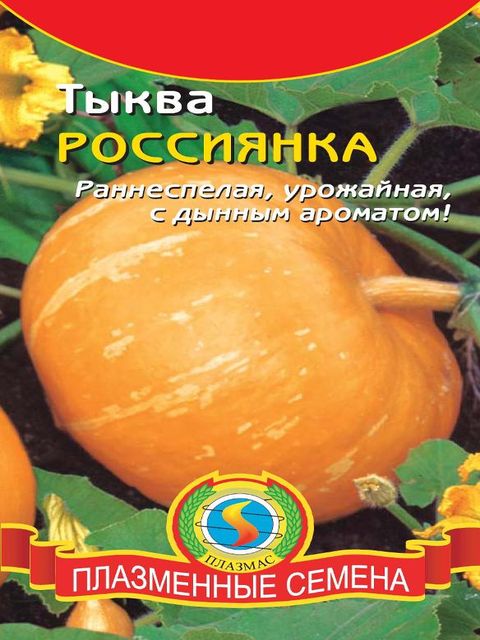

One of the most popular early maturing, versatile varieties. Ripening occurs 90-100 days after germination.
The plant is cold-resistant, medium climbing and power. The fruit is round, slightly turbid, the apex is convex, weighs up to 1.5 kg. This is an average weight, but can reach up to 4 kg with good care. The yield is also very good. From one bush, you can remove fruits weighing about 20 kg.
The valuable characteristics of the variety are its early maturity, high taste, good keeping quality and resistance to temperature drops.
The thickness of the crust is average, the outside is orange, there may be barely noticeable stripes. The pulp has a bright orange color, thick, crumbly, delicate sweet, there is a melon aroma.
The variety can be grown both in seedlings and sown directly in open ground. At the same time, seeds are sown for seedlings in April, and seedlings are usually planted in the ground in May - June. As for sowing directly into open ground, it should be carried out at the end of May - June. Depending on the soil, the seeds are sown to a depth of 3 to 5 cm.The planting pattern is 60 × 60 cm.
The plant is very fond of feeding in the form of organic fertilizers. When harvest time comes, it is recommended to remove the fruits together with the stalks. Stored well, but storage conditions should be: dry air and well-ventilated area.
When used for culinary purposes, microwaved meals are best obtained.
Classification of varieties by fruit shape
Depending on the shape of the fruit, the following types of pumpkin are distinguished:
- Rounded. The most common type of culture. Fruits come with a smooth skin or pronounced segmentation: Zemlyachka, Bun, Sweetie.
- Oblong. Fruits are elongated, their surface is smooth or slightly ribbed. Examples: Vitamin, Shrub Orange, Pink Banana.
- Pear-shaped.Differs in fruits of an oblong shape with a thickening at one end: Honey August, Pineapple, Arabat, Pearl.
- Complex. Representatives of this group have a complex or irregular fruit shape. These include: Goose in apples, Russian woman, Golden pear.
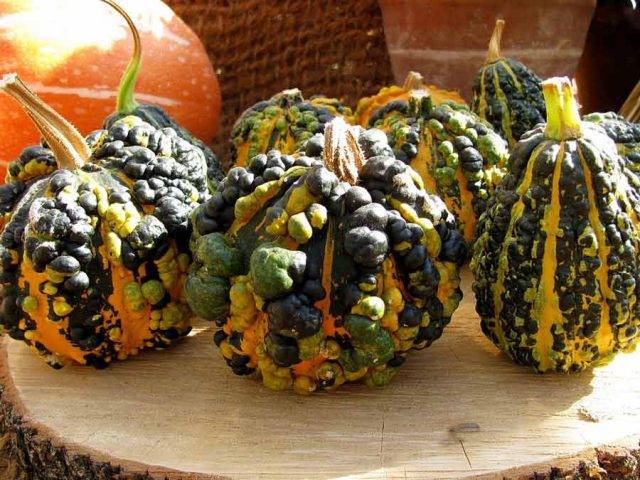

Caution! Many varieties with a complex decorative shape are not edible.
Bush pumpkin varieties for open ground
In the gardens, both climbing and bush pumpkin varieties are grown. Shrub plants are more popular due to the fact that they are compact and, almost all, are early ripening. Compactness is one of the important indicators. Shrub plants do not creep all over the garden, like climbing ones and do not form them.
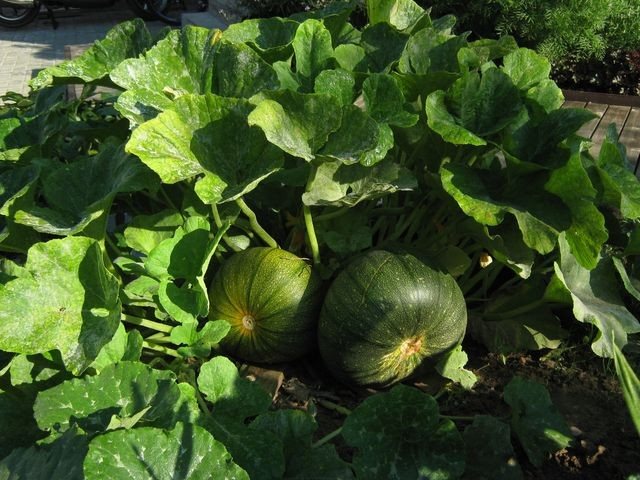

The fruits of the bush pumpkin are formed already at the very base of the stem. Climbing, on the other hand, forms rather long lashes. If they are not formed, then it will spread throughout the entire site. The fruits that form on the lashes will be difficult to find. Many gardeners use special arches for growing climbing gourds.
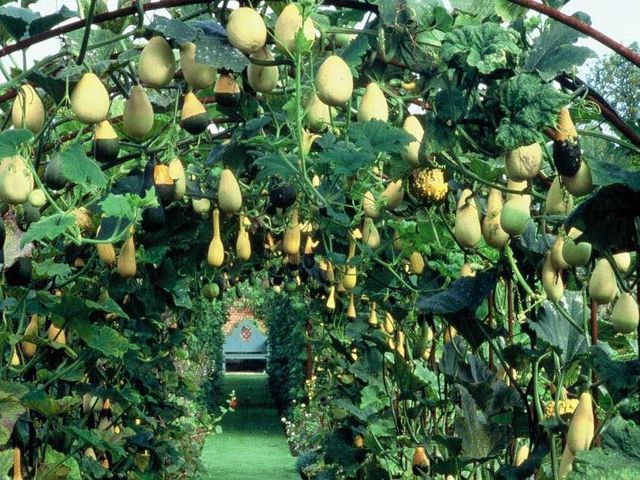

The second important property that distinguishes bush varieties from climbing ones is their early ripening. The fruits of the bush pumpkin are harvested 90-110 days after planting. There are also mid-ripening varieties, but late-ripening, practically. not.
Among the early ripening, the fruits of which can be harvested as early as 90 days, the most popular among gardeners are Amazonka, Smile, Acorn, Lel and Gribovskaya bush 189. Among the mid-ripening varieties, one can name the following varieties: Honey Beauty, Medicinal and Kustovaya Orange. The crop can be harvested as early as 90-110 days.
These varieties are cold-resistant, and therefore are well suited both for the southern regions of Russia and for the northern ones, for example, the Urals or Siberia.
Acorn
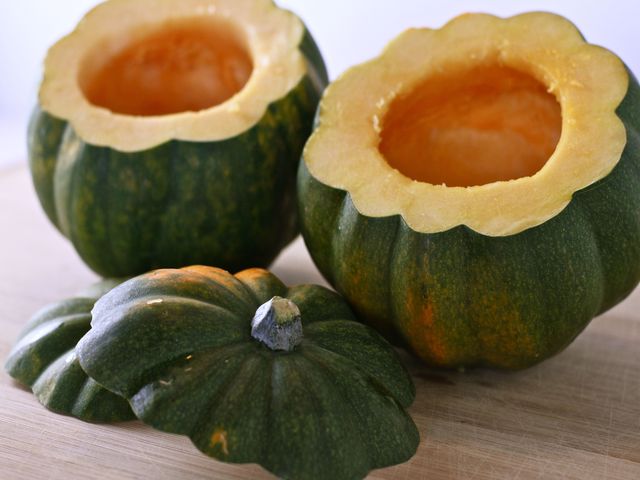

The variety also has a second name - "Acorn", apparently because of its appearance, somewhat reminiscent of an acorn. The fruits are medium, weighing about 1.5 kg. The taste is sweet, pleasant, creamy. The pulp is juicy and tender. The color of the pulp is yellow or orange. The bark is thick, so the variety belongs to the hard bark. Its color is not constant, it can be orange, green, and, moreover, it changes from dark green or marsh to gray.
Ripening occurs 85 days after planting. The pumpkin is planted according to the scheme 70x70 cm. It is fertilized only during sowing, although you can feed it later. It is planted in the ground usually in May-June, but for the first time it is covered with a film.
Lel
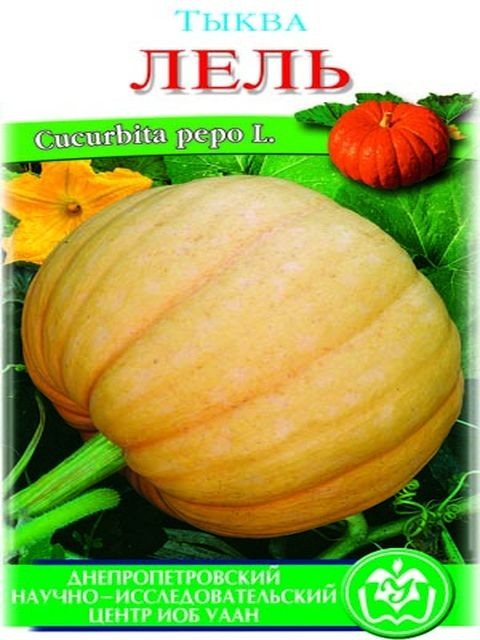

New variety. Fruits appear by the middle of summer, the harvest is harvested on the 90th day after planting.
The shape of the pumpkin is slightly flattened, there are ribs at the base. The skin color is yellow-orange with light brown stripes. It differs in that not so much pulp is used as food, but seeds, which are very valuable. They contain over 50% fat. The seeds are bare, they are used for food, for the preparation of oil, from which medicines are also prepared.
Hard-baked pumpkins
Hard-bore gourds get their name from their very thick, woody skin when ripe. Remember how difficult it is to clean a large zucchini that was kept behind the couch all winter? And because zucchini and squash also belong to hard-bore pumpkins, but now we are not talking about them.
Hard-bore pumpkins are good because they ripen early (in late August - early September), have not the largest fruits, but the most delicious seeds. Among this type of pumpkin there are bush varieties, which is very convenient in terms of saving space.
The peduncle of hard-bore pumpkins is ribbed with pronounced grooves, the stem is hairy and prickly, and the leaves are pentagonal.
Seeds are creamy with pronounced rims.
Muscat pumpkin varieties with photos and descriptions
Butternut squash differs from its counterparts in a much more subtle, nutmeg aroma and does not have that characteristic pumpkin flavor. Therefore, a group of nutmeg varieties is considered a delicacy on the table. Moreover, they are not the sweetest among all pumpkins, since they accumulate sugar only 6%.
They are no longer cooked as vegetables, but as fruits. Used nutmeg pumpkins for additives in porridge, they make salads and filling for pies, thick juices. It is also good in the form of jam.
Vitamin
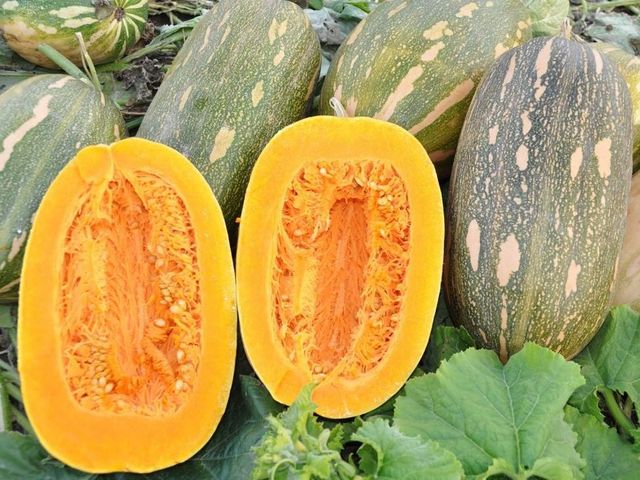

Medium late variety, ripens 130 days after planting. The fruits are oval, sometimes slightly cylindrical. The peel is brownish-orange colored, spotted and striped. The pulp is reddish, rather thick - up to 6-10 cm. There is little sugar in it, but there are many different vitamins, which is why it got this name. In addition, pumpkin contains carotenoids and ascorbic acid. Fruit weight reaches 5-7 kg.
Nectar
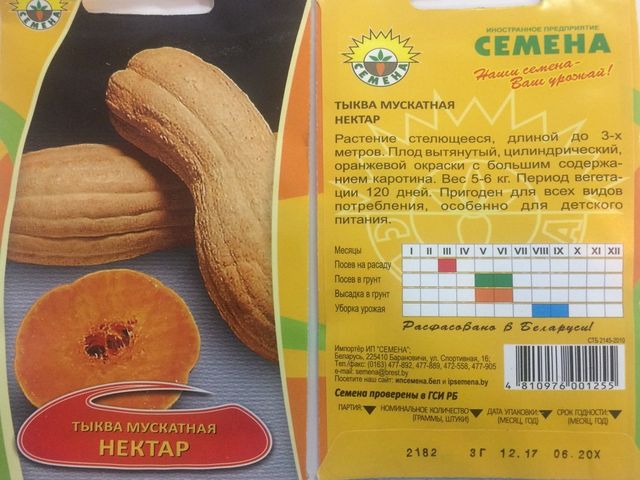

The plant is creeping, reaches a length of up to 3 m. Fruits are orange, ribbed, weighing up to 6 kg.
The pulp is bright orange, juicy and sweet, pleasant aroma. The use is universal, but juices and purees are best prepared.
Arabat
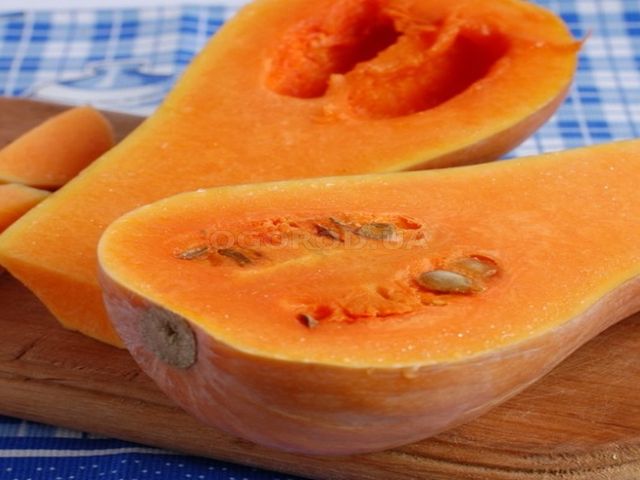

A medium late variety that has a long shelf life, almost 4-5 months. Therefore, it is suitable for those who like to eat pumpkin in winter. The skin of the fruit is thin, light orange in color. The pulp is dense, juicy and aromatic, has an orange color. The weight can be up to 8 kg.
Provencal


The variety is mid-season, ripening occurs in 120 days. The fruits are round, slightly flattened. The peel is not thick, ribbed, the color is dull orange. Weight reaches 8 kg.
The color of the pulp is bright orange, the taste is good. Moreover, the longer the pumpkin is stored, the better its taste becomes. For culinary purposes, it is best suited for making candied fruits, desserts and juices.
Honey princess
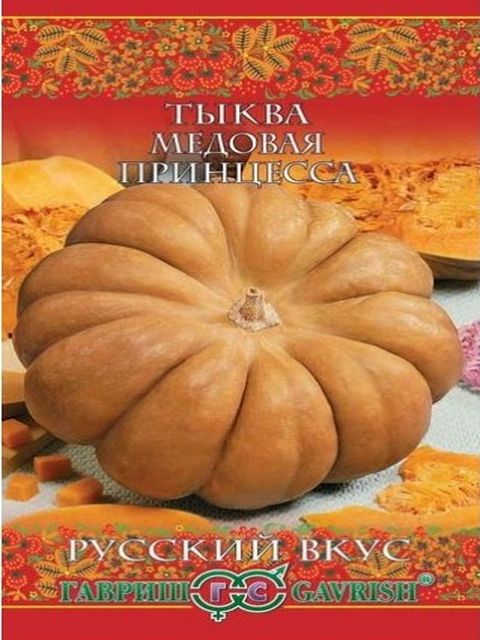

Like the previous variety, it is mid-season. Ripening occurs on day 115. Fruit weight is 4 kg, color is orange. The pulp is bright orange, the taste is sweet.
The plant grows powerful, and therefore it must be planted at some distance from each other. There must be at least 100 cm between the holes.
The variety is resistant to diseases and tolerates temperature extremes well.
Hokkaido
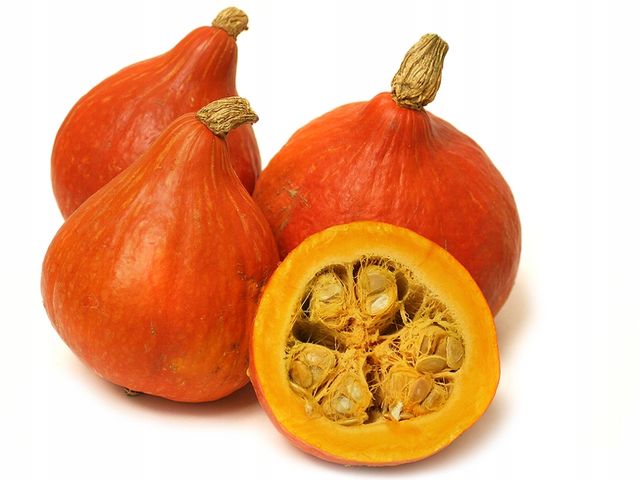

An interesting early ripening variety that has recently begun to gain popularity. Its shape is unusual, reminiscent of an onion, maybe in the form of a pear, as well as round or slightly flattened. By weight, the fruits are not very large and can reach from 700 g to 2.5 kg.
The flesh can be yellow or nearly red. It tastes like sweet potatoes. The peel is green, gray and white. Fruits contain a lot of useful substances. Demanding to watering and fertilization.
Spanish guitar
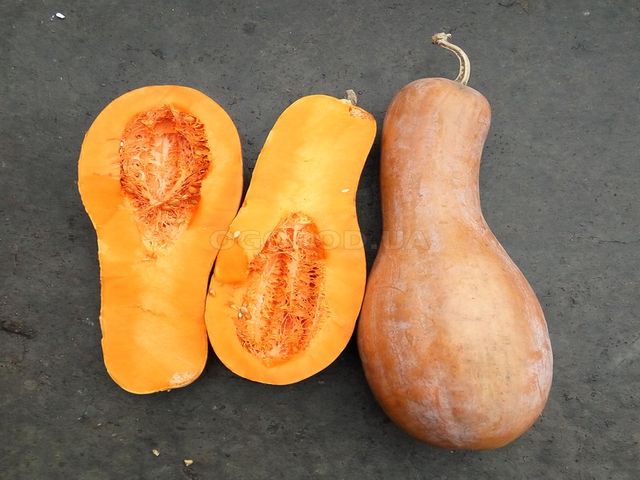

Another unusual in shape, medium-ripening variety. The fruit is in the form of a club or a guitar, which is why it got its name. The fruit grows up to one meter long and weighs from 5 to 10 kg. The peel is yellowish-green, the flesh is orange or yellowish. Juicy, sugary and crunchy, it tastes like carrots and apricots. The keeping quality of the fetus is about three months.
Large-fruited pumpkins
Large-fruited pumpkins, as you might guess, are the largest. But they are also the sweetest, the sugar content of some varieties reaches 15%, which is much more than in the sweetest watermelon.
The stalk of large-fruited varieties is cylindrical, rounded. The stem is also rounded and without grooves, and the leaves are kidney-shaped or close to pentagonal.
Seeds of large-fruited pumpkins are milky white, matte or brown in color. In addition, large-fruited pumpkins tolerate low temperatures better than others and are stored for a very long time in an ordinary apartment.
Sweet pumpkin varieties for outdoor use
Sweet pumpkins go very well as juices, fillings, cereals, preserves and compotes. Thanks to such a variety of uses, gardeners prefer to grow just such varieties.
Winter sweet
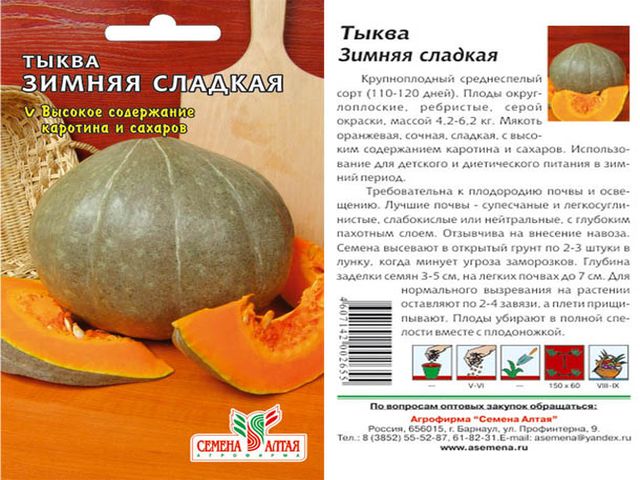

Popular enough. It can be mid-season or mid-late depending on the region and weather. The plant has long stems. Fruits weigh from 4 to 7 kg, but can reach 10-14 kg. Outside are mottled gray, and inside are orange-yellow.The pulp is not friable, sugar contains about 8%. When grown, it does not accumulate nitrates. Stored for a long time.
Marble
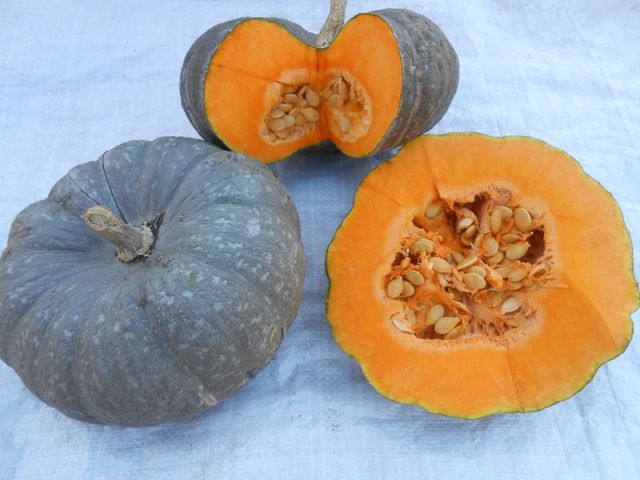

The variety belongs to climbing. Fruits are spherical-flattened in shape, with small ribs. Weigh 4 kg. the pulp is juicy and tender, it contains from 9% to 12% sugar.
Cracks on the peel, as well as white rot is not susceptible to. Stored for a long time.
Sweet chamomile
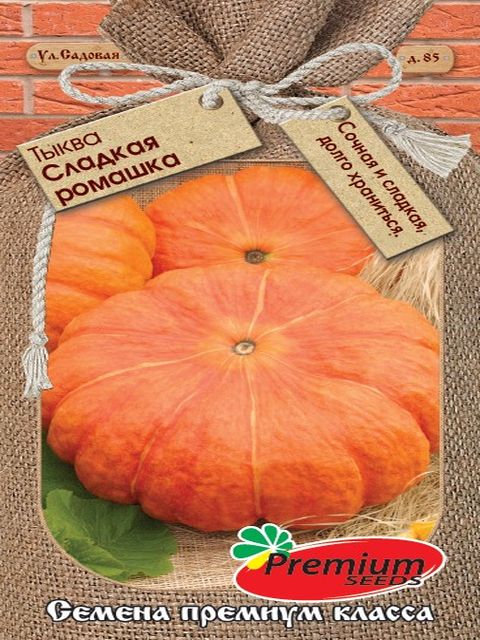

The variety is long-leaved, resistant to both cold and dry climates. It can be sown in open ground after the soil warms up to 10-12⁰С. After setting 3-4 fruits, it is recommended to pinch. The fruits weigh from 3 to 8 kg and have a rounded and flattened shape at the top and base. Has clearly visible ribs. The peel, although thin, is quite firm, the color is bright orange. The pulp is fleshy, up to 10 cm thick, it tastes sweet.
When growing for the whole season, it is necessary to apply mineral and organic fertilizers 2 or 3 times, which can increase the yield. Fruits are stored almost until spring. For culinary purposes, they are used for cereals, candied fruits, baked goods and baby food (for example, mashed potatoes).
Sweet chestnut F1
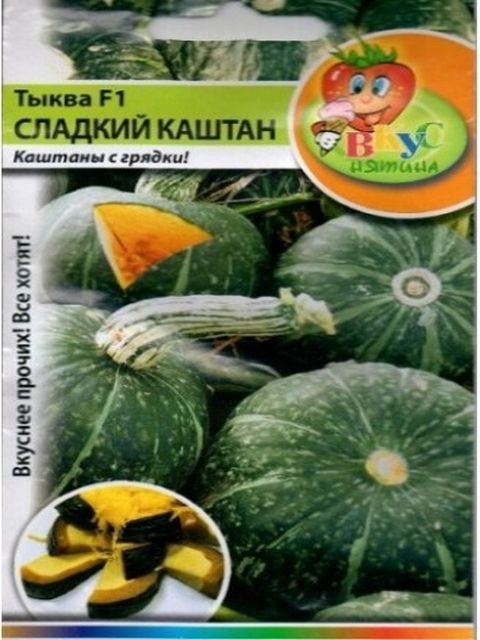

A hybrid variety, has small fruits weighing up to 600 g. The color is dark green, the shape is round, there are ribs. The pulp is sweet, starchy.
Colored: the most interesting species
Of interest to many gardeners are not classic orange, but colored pumpkins. In all groups there are fruits of an unusual shade from white and blue to green and black.
The most popular varieties with an unusual skin color are:
- Acorn. The rind is dark green and the flesh is bright orange and sweet. The pumpkin shape resembles an acorn.
- Marble. The peel is green-gray. Beneath it is a sugary, bright orange pulp.
- Pumpkin variety Gribovskaya. The peel is a delicate gray shade. The fruits are flattened. Late ripening.
- Kherson. The bark is bluish green. The pulp is crispy and sweet. Weight - up to 4 kg.
- Blue Hubbard. The crust is pale blue. The pumpkin is also interesting for its unusual bumpy relief, reminiscent of crocodile skin.
- White is a group of varieties. The peel is unusual light. The shape is oval.
- Kabocha is a rare pumpkin of Japanese selection. The rind is black.
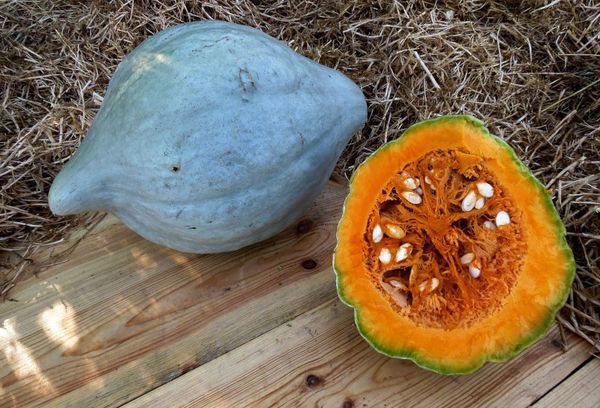

Decorative pumpkin, varieties with a description
In addition to varieties used for culinary purposes, there are varieties that are grown as decorative. They attract with ease of cultivation: the main thing is watering, feeding, loosening. Shaping, trimming, pinching, not needed. They also grow very quickly. Within a month, pumpkin whips can grow up to 5 meters.
The fruits of decorative varieties grow small up to 10-15 cm, and the weight reaches only 300-350 g.
Swan
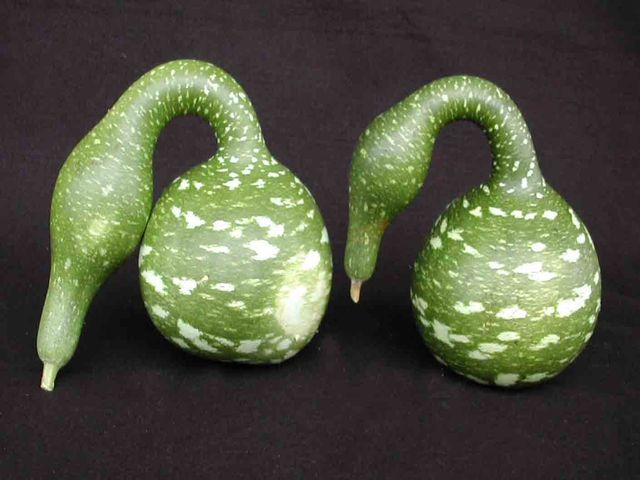

The variety is original in shape, similar to an elegant swan, for which it got its name. Fast growing, the lashes have large, rounded leaves. The plant is very fond of warmth, light and watering. Seedlings are planted in the ground when the soil and air warm up to 17 - 20 degrees. The peel of the fruit is dense, dark green in color with white specks. With proper care, from 8 to 12 pieces can be removed from one bush.
Using this variety, you can create such an interesting composition on your site.
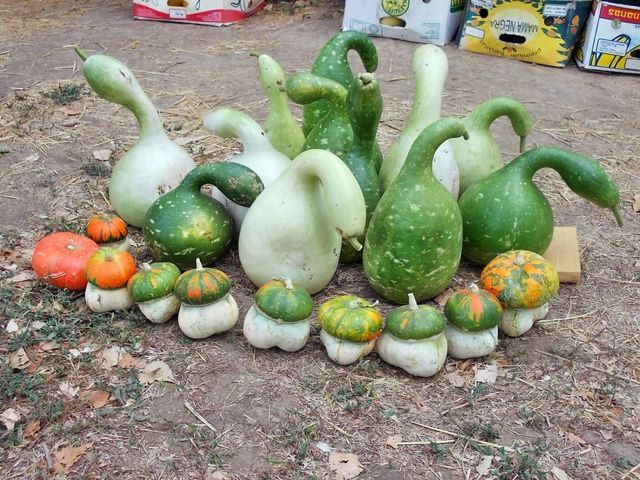

Pear
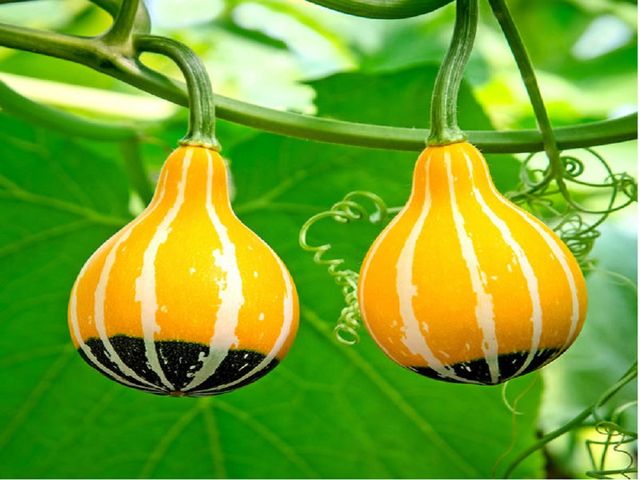

The pear-shaped variety, which is why it is so called, is distinguished by its original color. Fruits are not only one-color: yellow, cream, white, red, green and orange, two-color, variegated and cross-striped.
The size of the fruit is between 12 and 18 cm.
Crown
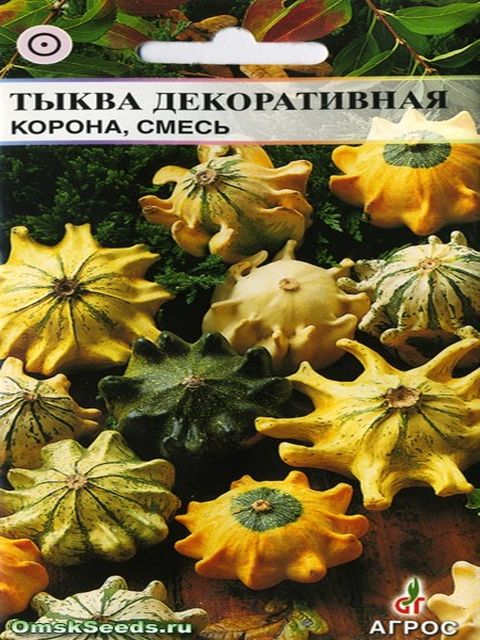

Unusual in shape. Fruits are bright yellow or yellow-green, up to 12-15 cm in size. In shape, there are star-shaped and umbellate fruits, but the main form is crown-shaped.
The stems are ribbed, grow up to 3-4 m in length. From them you can decorate a hedge or an arch.
Bottle
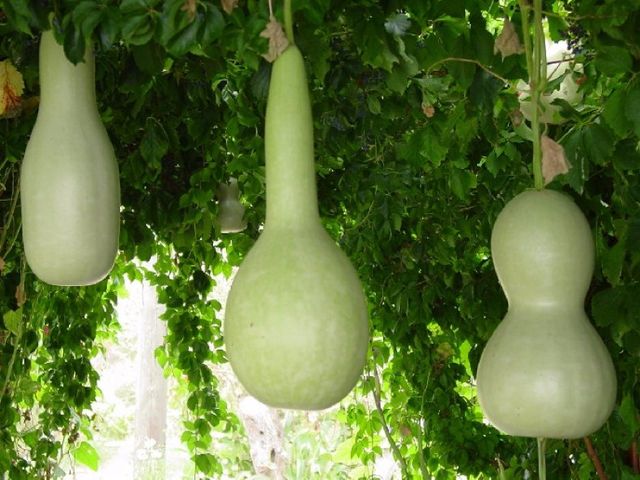

The variety is named so for a reason. It is similar in shape to a bottle or jug, has a narrow and elongated top and a rounded bottom. The variety is also called dish pumpkin and for good reason. Since ancient times, the fruits have been used to make jugs, bottles and flasks.
Fungus
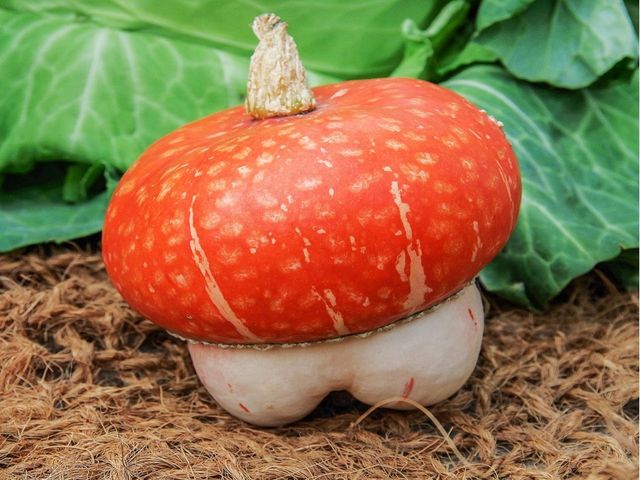

Another variety, original in shape, which looks like a mushroom. A variety of the group of turban pumpkins. The upper part of the fruit resembles a mushroom cap, massive and has different colors: orange, red, green. The lower part, like a mushroom leg, is somewhat smaller than white, speckled or pale green.
Frost and drought resistant, resistant to various diseases. The pulp is fibrous, watery with a bitter taste.
Farmers reviews
According to farmers' reviews, the cultivation of a pumpkin variety is not difficult, and adherence to simple care rules always guarantees a good harvest.
Larisa, Novorossiysk: “I really like the pumpkin: the fruits are beautiful, as in the picture, segmented. In terms of volume, they promise a lighter pumpkin. In reality, the fruits are heavy. The flesh layer is thick and sweet. The skin is easy to clean, thin. "
Leonid, Mytishchi:“During storage, it does not dry out and does not rot, it can lie until May. There are few seeds in the variety. I left it on purpose in order to collect it for landing. "
What varieties of pumpkin are suitable for open ground in the Moscow region
The Moscow region is the central strip of Russia and varieties suitable for this region are grown practically in the open field.
Titanium
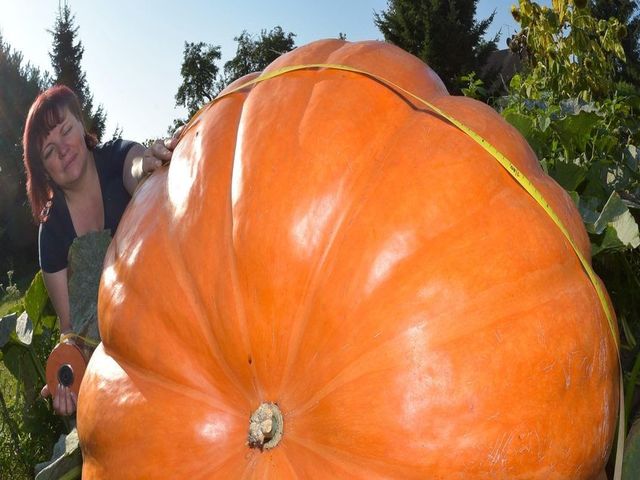

The name justifies the appearance of the plant. Perhaps this is the only variety, the fruits of which can reach 100 kg. The pumpkin is round in shape, the peel is orange. There are very few seeds in the pulp. Scourges of plants reach three meters. The taste is good.
Atlant


Another large-fruited variety of medium late ripeness. Fruits are round, smooth with slight segmentation. The peel is yellow-orange, the pulp is soft, juicy, orange. It accumulates oils and beta-carotene. The mass reaches 10 kg.
It has a high yield, 2.7 kg of pumpkins can be harvested per square meter. The fruits keep well. It is used both raw and for processing and juicing.
Among the sweet varieties, I would like to highlight such as Kroshka.
Small-fruited, early maturing. The crop ripens 3.5 months after sprouting. The pumpkin is round, ribbed. The rind is light gray. The pulp is bright yellow and firm. The weight is about 3 kg. Can be stored for up to 5 months.
Crumpet
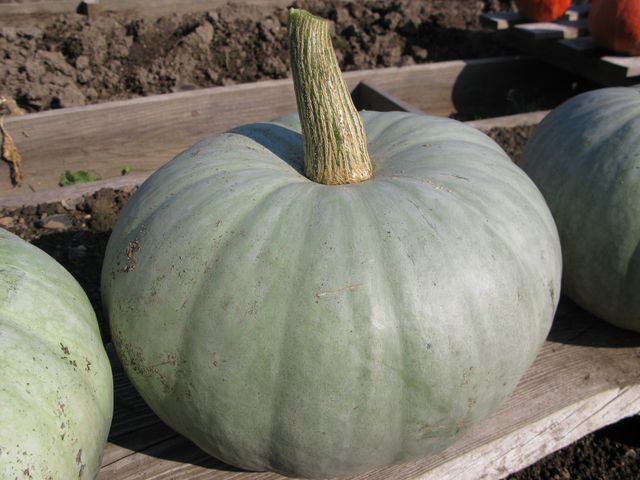

It is grown by seedlings. Maturation occurs in 3 months. Oval shape, cream peel. The pulp is bright orange, firm and juicy. The weight of the fetus reaches 7-8 kg. The variety is the sweetest, it contains 10% sugar.
Almond
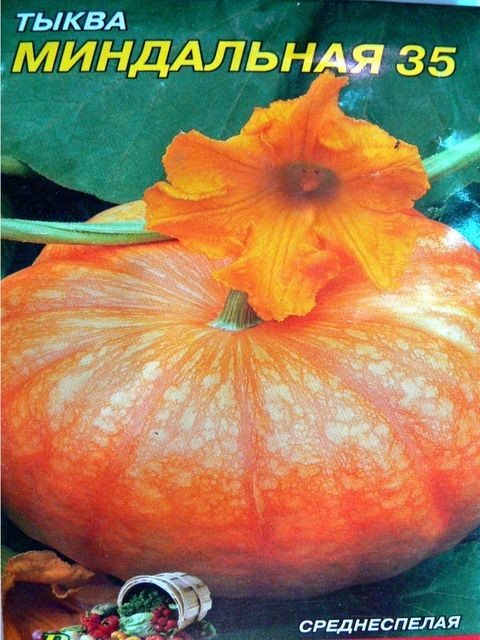

The variety is mid-season and gives a good bountiful harvest. Medium size, round shape, weighs from 4 to 8 kg. The flesh is firm, orange in color. The fruits can be stored for a long time, about 6-7 months. At the same time, the taste does not change.
How to grow
The quality of the planting material, the correct planting and the fulfillment of all care requirements affect the growth and yield.
Planting by seeds or seedlings
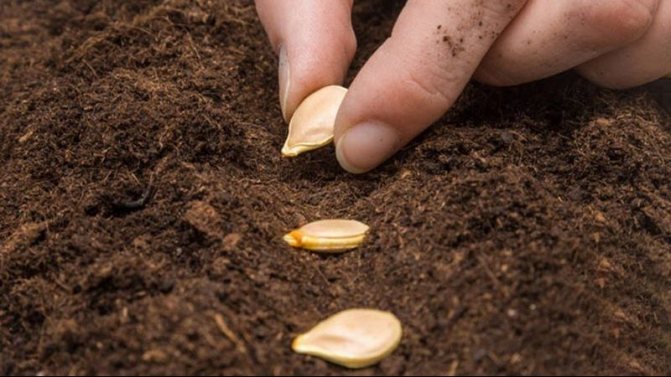

For planting, it is preferable to choose freshly harvested seeds. Suitability can be determined by placing them in a container with water for 1 hour - floating seeds are discarded. Seeds that have mechanical damage, signs of mold, yellowness, diseases are also not suitable.
To kill the pathogenic microflora, before planting, the seeds are heated at a temperature of 40 ° C for 9 hours, and then etched for half an hour in a weak solution of potassium permanganate.
The planting method depends on the local climate. In the southern regions, seeds are sown directly into open ground. In the middle and central lane, as well as in the northern regions, the seedling growing method is used.
Open field seed planting technology:
- 2 weeks before sowing the seeds, the soil is fertilized with humus (1 bucket per 1 m² of soil), dug up and leveled;
- at a distance of 100-150 cm from each other, pits are dug with a depth of 4-6 cm;
- each hole is watered and 2-3 seeds are placed, covered with earth and irrigated, you can cover with a film until shoots appear;
- after emergence, the film is removed;
- 1-2 of the strongest sprouts are left, if 2 seedlings are left, then their shoots are sent in opposite directions.
Pumpkin varieties for open ground for the Leningrad region
The Leningrad Region has a special climate, and not all plants that are grown in neighboring regions can grow here. Therefore, breeders develop varieties that are recommended specifically for the Leningrad region.
Mozoleevskaya 49
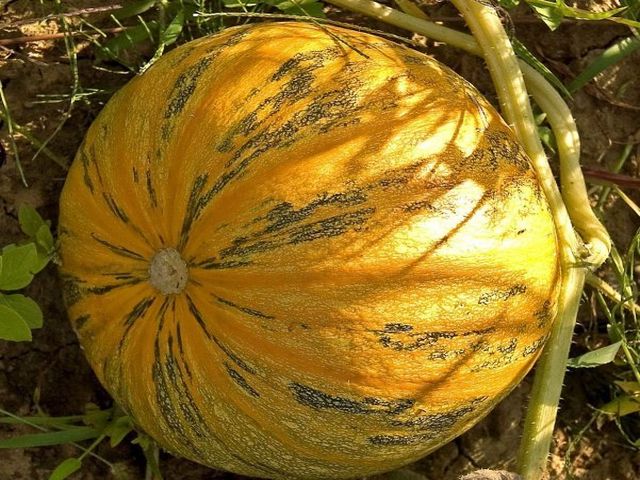

Mid-season, ripens in 110-120 days. Fruits are yellow-orange in color with greenish-brown stripes, have a short oval shape, hard peel. The mass reaches from 4 to 5 kg. The pulp is also yellow-orange.
Hybrid 72 is a climbing variety with large fruits. Their weight reaches 8 kg, the shape is almost spherical. The color is light gray and greenish gray. The pulp is yellow and medium sweet. Ripening occurs in 120-125 days.
Red Baroness
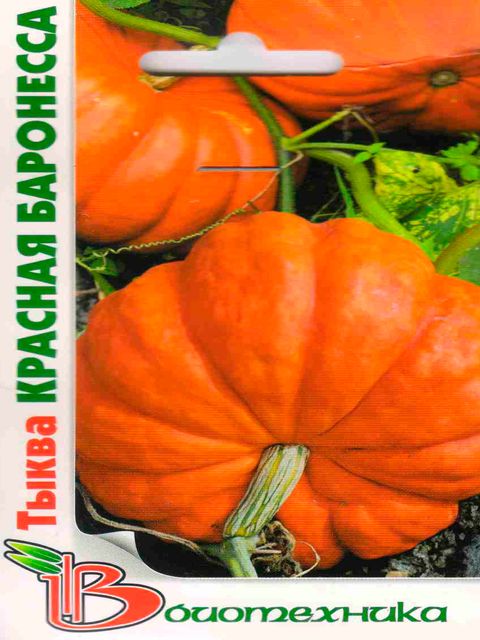

The variety is mid-season, resistant to cold and high humidity.
Fruits are bright red and weigh from 5 to 8 kg. Grows poorly on poor soil, susceptible to fungal diseases. Can be grown both outdoors and in a greenhouse. Well suited for cooking and main courses and pastries. Stored well.
Pineapple
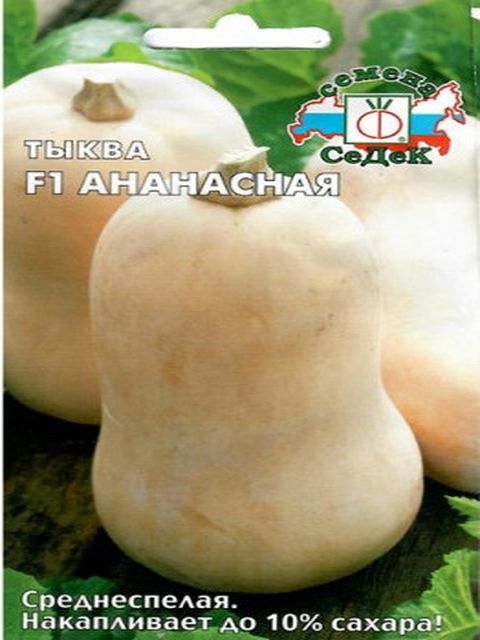

The variety is mid-season. Fruits are pear-shaped and weigh from 2 to 3 kg. They contain a lot of sugar and they keep fairly well. The aroma of the pulp is fruity, which is the reason for the name. Feels good in wet and cool summers.
Harvesting and application of the crop
Harvest after the plant stems begin to dry out. Cut the pumpkins, leaving tails at least 10 cm long... When temporarily outdoors, cut pumpkins are protected from the sun's rays. To prevent the fruits from rotting, do not allow them to come into contact with each other.
In winter, pumpkin is stored in cool, well-ventilated rooms with low humidity levels, at temperatures from 5 to 15 ° C. Compliance with optimal conditions contributes to the preservation of fruits for 5-7 months.
Kapitoshka pumpkin is used for making pureed soups, cereals and casseroles, as fillings for pies. Can be eaten raw in salads and juices, dried and dried. It has a beneficial effect on digestion, improves metabolism, strengthens the immune system, and helps to cope with insomnia and depression. It has dietary properties and is suitable for feeding babies.
For the northwest
If you are going to grow a pumpkin in the north-west of Russia, then you should choose the following pumpkin varieties:
- Shrub orange. Early ripening variety. The fruits are presented in the form of a ball, have a bright orange color. Pumpkin weight reaches 4-5 kg. The pulp is yellow and contains a large amount of sugars and dry matter. The main advantage of this variety is its high yield and early maturity.
- In the northwest, an excellent option would be to use varieties such as Troyanda and Prikornevaya. They have a quick ripening period, high yields. The fruits are all 4.5 - 7 kg. The core has excellent taste and is presented in an orange-yellow color scheme. The varieties are resistant to common diseases. Fruits retain their taste and presentation for a long period of storage.
- Shrub. This variety is in great demand among gardeners and gardeners. It is characterized by small fruits. Ripens early. The plant develops in the form of a bush. Fruit weight 1.5-2 kg, have a yellow-green color. The pulp is yellow, juicy and tasty.
For the Moscow region and the Middle Strip
Despite the fact that experienced gardeners successfully grow foreign and southern varieties of pumpkins, it is best to use domestic varieties, zoned for central Russia and the Moscow region.
Early Healing - how to plant
The fruit is early ripe, able to withstand drought and cold.The first fruits ripen on day 94. The culture is medium-sized. The shape of the pumpkin is flat-round.
The mass of one is 2.5-3 kg. The vegetable has an orange peel, no pattern. The core is orange, medium thickness, dense, juicy. When storing pumpkin for six months, the taste remains unchanged.
Therapeutic
The variety belongs to the early maturing. Harvesting can be done 90 days after germination. The plant is of small height, the fruits have a flattened shape, the weight of one is 3-5 kg.
The rind is thin and the flesh is very juicy and crunchy. When stored for a long time, the pumpkin retains its presentation.
We recommend that you familiarize yourself with the most productive varieties of tomatoes for open ground in this material.
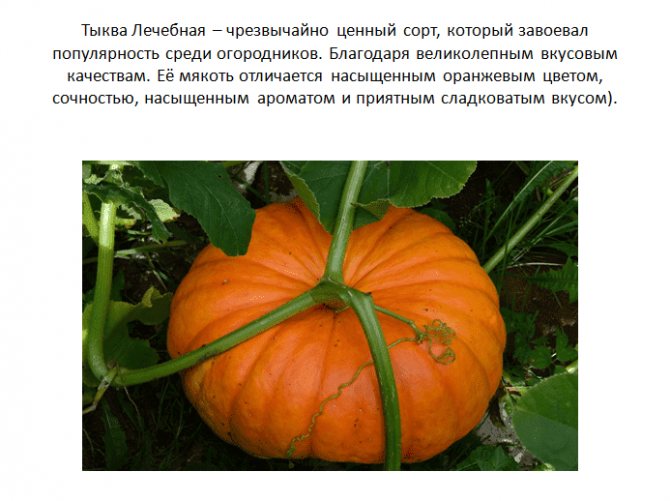

You will find a list of undersized varieties of tomatoes for open ground in this article.
Early ripe variety Sweet pie
The variety is characterized by its high yield and early ripeness. Pumpkin is presented in orange-red color scheme, rounded shape and smooth surface. The weight of one product is 2-3 kg. The heart has excellent taste, juicy and sweet.
Candied fruit
The variety is accompanied by high fruiting and early ripening. The fruits are flat-round in shape. The mass of one pumpkin is 5 kg. The pulp has a yellow-orange color. It contains a large amount of carotene and sugar.
Early varieties of tomatoes for open ground are presented at the proposed link.
Premiere
The culture bears excellent fruit in cold conditions. Fruit ripeness is average. Already on day 115, harvesting can be done. The culture is long-looped. The fruits are presented in a flattened shape. The color is dark green, there is a coarse mesh.
The pulp is presented in bright orange color. Its thickness is 3-5 cm, dense consistency. The fruits are high in sugars. The culture develops well when planting seeds in open areas. On one plant 2 fruits ripen, the weight of which is 5-6 kg. When storing pumpkin for six months, all taste remains unchanged.
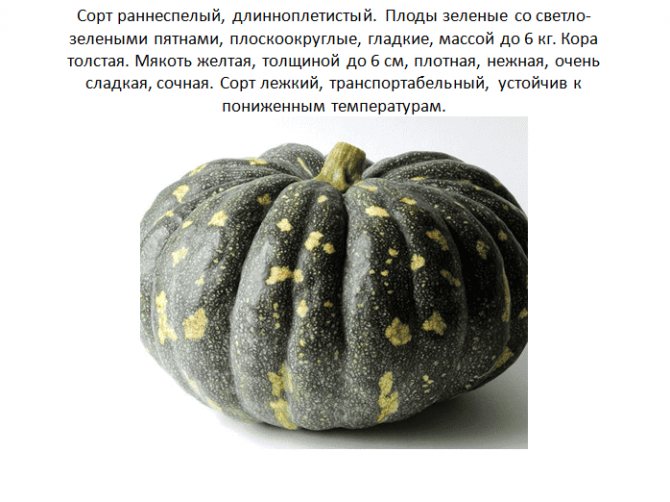

We also recommend that you familiarize yourself with the best varieties of tomatoes for open ground.
Gribovskaya winter
Late ripening variety. Harvesting is observed on day 128. Fruits have a flattened shape, gray color, no pattern. The mass of one pumpkin is 3-4 kg. The flesh is thick, its color is bright orange. Grow such a plant through seedlings. You can store the fruits until the new harvest.
Freckle
The variety is able to resist the cold. Harvesting takes place 80 days after germination. This culture is characterized by marble leaves and dark blotches on the fruits. The plant develops as a bush. One bush can have 4-5 fruits.
The mass of one can reach 1.8-3 kg. The pulp has a sweet taste, crunchy, and its thickness is 3 cm. Fruit ripening occurs quickly and evenly. The product can be used for food immediately after collection.
Gribovskaya bush 189
Early ripening variety. Harvesting begins on day 80-98. The size of the culture is compact. The vegetable has an obovate shape, the color is yellow, there are stripes of dark green. Fruit weight 2-5 kg.
The core has excellent taste. You can store the pumpkin until December, since the taste remains unchanged.
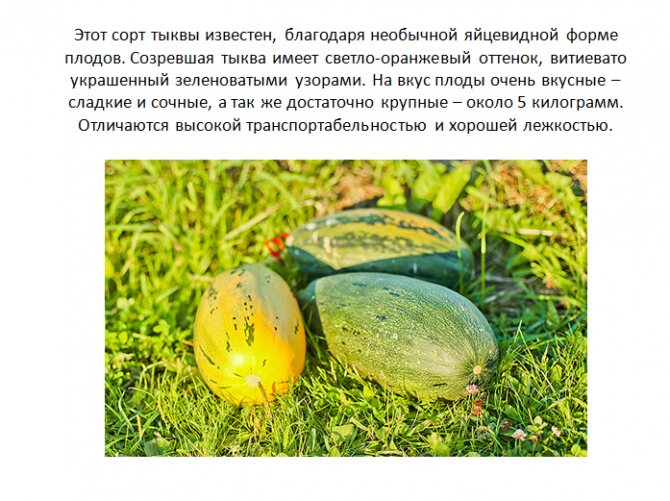

Dachnaya
Early ripening variety. You can harvest the crop for 80-90 days. The culture grows with a bush, the size of which is compact. The fruits are presented in the form of an oval.
The surface of the pumpkin is smooth, the ripe fruit has a yellow color, and its weight is 2-4 kg. The pulp is yellow, has a dense texture, the taste resembles vanilla. The palatability is preserved for 4 months of storage.
General information and classification
There are three main types of pumpkin:
- firm-mouthed;
- large-fruited;
- nutmeg.
In a vegetable crop, pumpkin varieties in each variety are bush or climbing, portioned or with large fruits, sweet and semi-sweet, with a large and small content of seeds. In addition, fodder, dining and decorative groups of vegetable crops are distinguished.
Any type of pumpkin is suitable for outdoor cultivation. When choosing, take into account the purpose of the future harvest, the size of the land plot, climatic features.
Common pumpkin is an annual herb with a slender, creeping stem up to 8 meters in length. Along the entire length of the cylindrical or faceted stem, many branches are formed - antennae. The leaves are large, painted in a green-waxy color. The shape of the leaves can be round-triangular, pentagonal, kidney-shaped. To the touch, the surface of the leaves is hard with fluff.
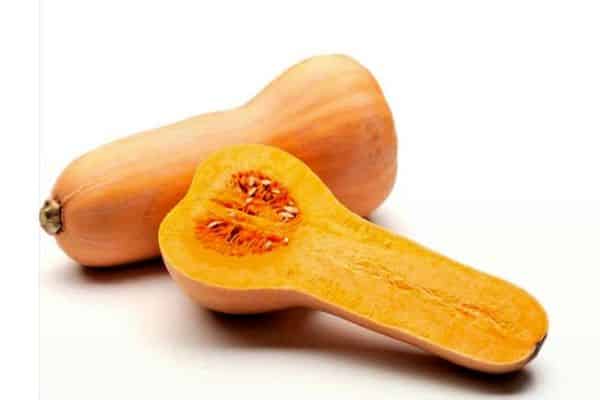

The plant blooms from June to autumn. Bell-shaped pumpkin flowers are light yellow or orange in color with a pleasant aroma. Fruits are formed in different shapes and may vary in color. The pulp is yellow or orange, juicy and sweet.
Hybrid varieties
Among the pumpkin varieties, the hybrid varieties are prized for their taste and quality. In addition, the plants are characterized by increased resistance to adverse weather conditions and errors in care. The names of popular pumpkin hybrids: Kashtanka F1, Favorite F1, Orange honey F1.
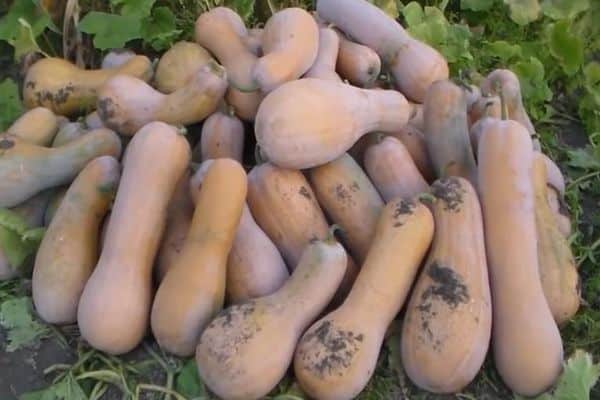

Kashtanka hybrid for table purposes, refers to mid-season crops. Harvesting begins in 115 days. The plant has long lashes with numerous portioned fruits. The shape of the fruit weighing 2 kg is flat-round, with a slight ribbing. The skin is light green with light gray stripes.
The taste qualities of the Kashtanka hybrid are high, vegetable growers receive a consistently high yield even if agrotechnical requirements and bad weather conditions are not followed, the crop is suitable for long storage.
The hybrid Lyubimitsa is considered a mid-season. The growing season lasts 120 days. Table vegetable. The plant forms long lashes with numerous portioned pumpkins. Fruits weighing 2.5 kg are flat-round, the skin is dark green with light green stripes.
The pulp of the fruit is bright yellow, juicy, dense and aromatic. Suitable for dietary and baby food. The harvested crop is suitable for long-term storage.
How Do I Pick a Good Pumpkin?
Have good pumpkin the rind is firm, but not "woody". Of course, there should be no cracks and soft spots, dark spots on it - the latter indicate that the pumpkin has begun to rot. When choosing a pumpkin, you should not chase giant ones. Overgrown, overgrown fruits may have dry, watery and bitter flesh.
Have ripe pumpkins the tail is dark and dry. If there is no tail, it is better not to buy, perhaps the seller got rid of it on purpose, since the vegetable was picked ahead of time and did not have time to ripen. Moreover, even the best pumpkinleft without a stalk is stored much less.
Pumpkin pulp, "Recovering" from fungal diseases will be very tasteless and bitter. Dents, dark or pinkish spots on the peel may indicate a possible lesion. Also, unscrupulous sellers often cut off the affected areas - and sell the pumpkin piece by piece.
Which pumpkin is best? It all depends on what needs to be prepared from it and how long it is planned to be stored. Most often, there are three types of pumpkins in markets and shops: hard-barked, nutmeg and large-fruited. There are also decorative ones, but they are usually not suitable for food.
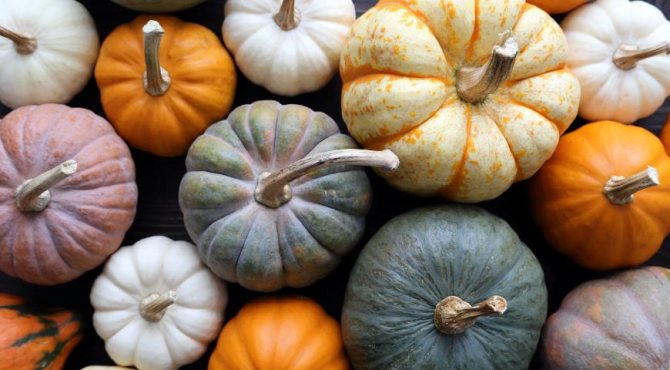

There are a dozen different varieties of pumpkins in the markets.
Hybrids
These varieties are obtained by crossing several varieties of culture at once. This makes it possible to obtain a plant with higher characteristics.
Benefits of hybrid species:
- the plant produces fruits of approximately the same size;
- the species gives a high yield under any conditions;
- hybrids are practically not exposed to diseases and pests;
- self-pollination.
Among the shortcomings, it is worth noting:
- plants are demanding on the mineral composition of the soil;
- it is impossible to overmoisten the soil;
- do not like drought;
- additional feeding is required.
Among the pumpkin culture, the best hybrid representatives are:
- ruddy crumpet f1;
- pumpkin Matilda f1;
- crumpet f1;
- pineapple f1;
- pumpkin atlas f1;
- gourd hazelnut f1.
In addition to the species that are widely used in cooking, there are decorative varieties. The most famous are "Goose in apples" and "Black". These vegetables have an interesting appearance and will become a real decoration of the personal plot.
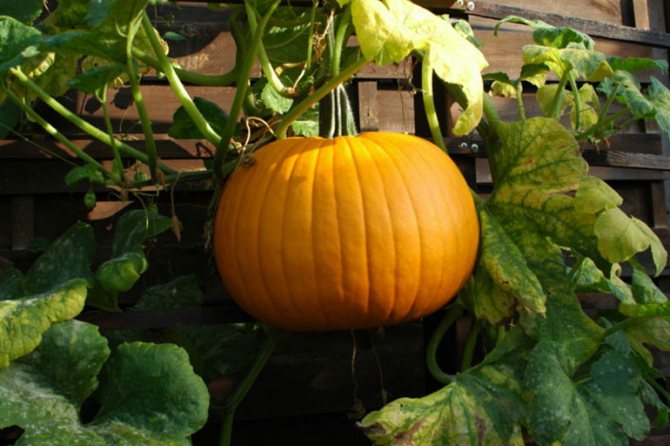

Pumpkin is a healthy and tasty vegetable. She diversifies any table. Modern breeding has made great strides in developing varieties of this crop. Each gardener will be able to choose a species that will meet all his requirements.
It is customary to subdivide pumpkin varieties into sweet and slightly sweet. This classification is very arbitrary, but very significant in cooking. In terms of taste, sweet varieties are close to fruits, and this determines their role in our diet. We've reviewed the sweetest pumpkin varieties for you, as well as pumpkins with different pulp flavors.
Long-term storage at room temperature is what makes the pumpkin stand out from other vegetables. Its healing properties are great, provided by group A provitamins (carotenoids), minerals, phytosterols. Pumpkin is not too high in calories, useful for adults and children (excluding those who are allergic to this product).

